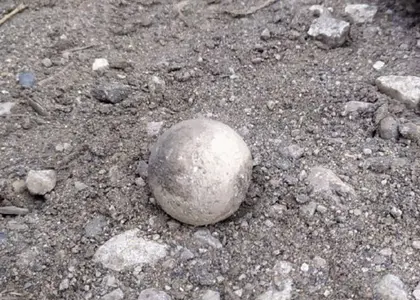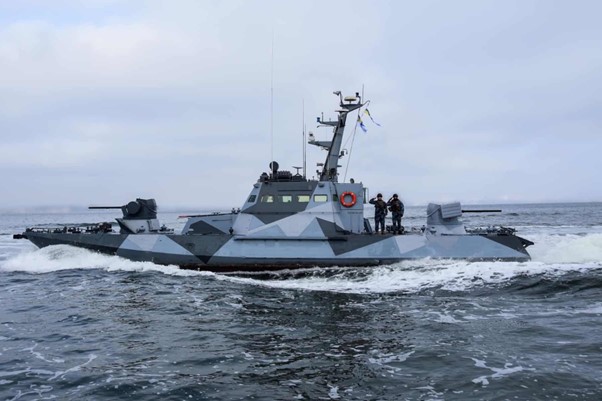Sergei Aksyonov, head of occupied Crimea, said on Tuesday that unexploded cluster munitions from one of the six US-supplied ATACMS reportedly intercepted over Crimea “scattered” in the area and warned residents not to approach.
The announcement also came with a picture of a metal sphere roughly the size of a baseball, purported to be an unexploded ordnance from an ATACMS, found in the village of Dons’ke, approximately 13 kilometers (8 miles) from Simferopol city.
JOIN US ON TELEGRAM
Follow our coverage of the war on the @Kyivpost_official.
“After the ATACMS missiles were shot down, the undetonated submunitions scattered. If you find this ammunition, do not pick it up, do not approach, call the Ministry of Emergency Situations and the Ministry of Internal Affairs,” said Aksyonov on Telegram.
On the same day, Russia’s Ministry of Defense claimed to have intercepted a number of ATACMS and French-made Hammer aerial-guided bombs.
“Over the course of 24 hours, air defense systems shot down ten Ukrainian unmanned aerial vehicles, six ATACMS operational-tactical missiles made in the USA and two Hammer guided bombs made in France,” read its Telegram update on April 30.
Moscow’s announcements also followed news of Washington’s secret delivery of long-range ATACMS to Kyiv in March, as opposed to the earlier versions with a limited range chosen for delivery in fear of further degrading Moscow-Washington relations.

Partisans Inform Ukrainian Forces of Russian Military Boat Locations in Crimea
So, did Russia shoot down US-made ATACMS over Crimea?
Kyiv Post’s subsequent investigations believe the metal object is extremely unlikely to have come from an ATACMS missile – nor resembles any form of cluster submunition – though whether Ukraine used ATACMS in the Crimean strike is debatable.
Identifying the metallic object
Aksyonov was not the only one who reported the sighting of similar metal spheres in Crimea. Vladimir Rogov, a pro-Kremlin milblogger, also shared an image of something similar on the side of the road, which better depicts the sphere’s size.

While the ball’s size resembles the M74 bomblets used in ATACMS, there’s a catch – there’s no metallic sphere inside an M74 bomblet.

The diagram of an ATACMS Block I missile above was posted by an open-source intelligence page called OSINT (Uri) on X (formerly known as Twitter) in October 2023, when the use of ATACMS was first recorded in Ukraine. The image likely originated earlier, with one of the earlier sightings on the internet being traced to 2019 on a Japanese site through a reverse image search. Kyiv Post is unable to trace the true origin of the photo.
Collective Awareness to Unexploded Ordnance (CAT-UXO), an explosive hazard advocacy group, also provides a detailed description of the M74 bomblets’ functions and operations, with photos.

Photos from the ATACMS usage in late 2023 also showed the aftermath of its detonation, including fragments of the M74 bomblets. Notice the patterned fragmentation wall.

In short, the bomblet consists of a central fuze enclosed by explosives, then a tungsten fragmentation wall, and finally the steel casing with raised aerodynamic ridges (flutes) – no metallic spheres.
Whatever was depicted in the pictures from Aksyonov and Rogov were not the M74 submunitions from an ATACMS missile. A subsequent search on CAT-UXO’s list of known submunitions also did not show similar metallic spheres depicted in the pro-Kremlin Telegram announcements.
Did Ukraine fire its new ATACMS?
However, it is possible that Ukraine fired ATACMS towards Crimea on April 30 – though the evidence is circumstantial at best.
At present, there is no physical evidence or official statements from Ukraine that suggest ATACMS were used in the Crimean strike, though a series of air defense installations were targeted, potentially as part of a bigger operation, as detailed in a recent Kyiv Post analysis.
But striking those targets would require deep strike capabilities, which reduce the number of probable candidates used for the strike to few – including the newer Block IA variants of the ATACMS many believed were recently supplied to Ukraine, whose cluster warheads were equipped with fewer bomblets for extended range.
Theoretically, it is also possible that Storm Shadow cruise missiles or Soviet-era Tochka U missiles, armed with reduced cluster payload for extended range, were used in the strikes – but without physical evidence, the observations are now speculative at best.
You can also highlight the text and press Ctrl + Enter










